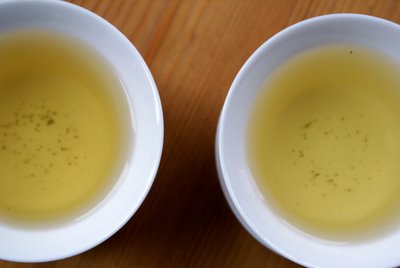A large leaf feast
-721958.JPG) A recent post on another (excellent, BTW) blog triggered the following comparative session of two Houkui teas.
A recent post on another (excellent, BTW) blog triggered the following comparative session of two Houkui teas.
Houkui is one of the most renowned green teas of China. It comes from the center-eastern province of Anhui, also home to Guapian (another famous green) and Keemun (China’s premier black tea). The best Houkui is reputed to come from the district of Taiping. So Taiping Houkui can be considered a ‘tea appellation’ similar to e.g. Brunello di Montalcino or Saar Riesling. Literally, the name is translated as Monkey King (several other Chinese teas were once allegedly picked by monkeys).
Houkui has a very special and spectacular appearance. While most top-quality green tea from China is made from very small leaves and buds (following the assumption that the youngest leaves yield the best tea), Houkui has huge leaves. They often reach 5 cm in length (and are said to exceed 15 cm before drying); this is due to the used tea varietal, not a lower grade of tea (in fact, the first two tender leaves are used, sometimes with a bud). They are rolled into a flat blade style, a bit like Longjing, but are greener, and show a distinctive chequered pattern left by the woven cloths used for rolling the leaves. For an excellent summary of Houkui, see here.
The following are tasting notes from a side-by-side brewing (3g of leaf for approx. 85ml water) of two Houkuis. The Taiping Houkui (hereafter ‘A’) was purchased from a Polish internet teashop, eHerbata, and cost the equivalent of 15 € per 100g. The second tea, 2008 Supreme Houkui (‘B’), is from Dragon Tea House ($26 / 100g).
Dry leaf:
A: Typical chequered leaf, greenish but also a fair bit of light brown: honestly doesn’t look like the freshest 2008 harvest. Aroma is quite distinctive: button mushrooms, followed by a thicker, almost chocolatey impression.
-728678.JPG) Taiping Houkui from eHerbata.
Taiping Houkui from eHerbata.
B: An obviously high leaf quality, mostly dark green on colour, long, with relatively little damage to leaves. Aroma is a quite intense impression of cooked spinach, plus some chestnutty notes reminiscent of Longjing (the latter aroma reinforced by warming leaves).
-727791.JPG)
2008 Supreme Houkui from Dragon Tea House.
Tasting notes (brewings of 60s @ 80C, 45s @ 85C, 90s @ 85C):
A: Lid aroma is unremarkable, dusty and chewy. Also a mildly unappetizing brownish colour. I get a bit of metallic character on palate but not bad, with a good moment of vegetal-grassy intensity (vaguely reminiscent of lower-grade sencha). Quite some grip on end, this tea tends to become very bitter if infused too long; be careful! Becoming rather bland by infusion #2, still with decent thickness and balance of flavour but undistinctive. #3 is OK but with almost no fruit left, and hollow at mid-palate. Leaves are mostly fragmented, there is little intact leaf, but a bit of twig.
B: Good lid aroma, nutty and chestnutty with good density. Clean yellow-greenish colour. A pleasant, ‘elegant’ nose, with a vegetal spectrum: snap peas, asparagus, hay, and a balanced, mildly chlorophile-bitterish finish. Increasingly beany flavour with time. Later brewings are notably less precise and complex now, with a more muted finish but still very satisfying, with good flavour. Anything beyond brewing #3 is rather bland and neutral but not unpleasant. Sources often indicate an ‘orchid’ note in the Houkui bouquet, but I found none here.
Overall:
A: Rather fragile, not terribly fresh, easily overbrewed but if handled carefully this gives a fairly elegant, vegetal, light-bodied but clean tea. A good 3 more steepings.
B: Classy tea here, and worth the highish price. A distinctive flavour profile, clean, good patience. Recommended.

Brewing #3; tea A on left, B on right. Colour is almost identical by now but A is a little browner.
An aside note on water temperature. In the above-quoted entry from La Galette de Thé, Philippe mentions pouring cold water on the leaves first, then adding the balance of boiling water in order to reach the desired 70–80C. I find this method highly unsatisfying. In my experiments, cold water invariably resulted in green teas tasting ‘watery’, vague and unintense, without the texture and sprightliness I expect from the best qualities. I much prefer to pour boiling water in a reserve pot and wait two or three minutes for the water to cool down, or pour from one empty (cool) pot into another and then on the tea. I find this an easy way to obtain water at 75–80C.

